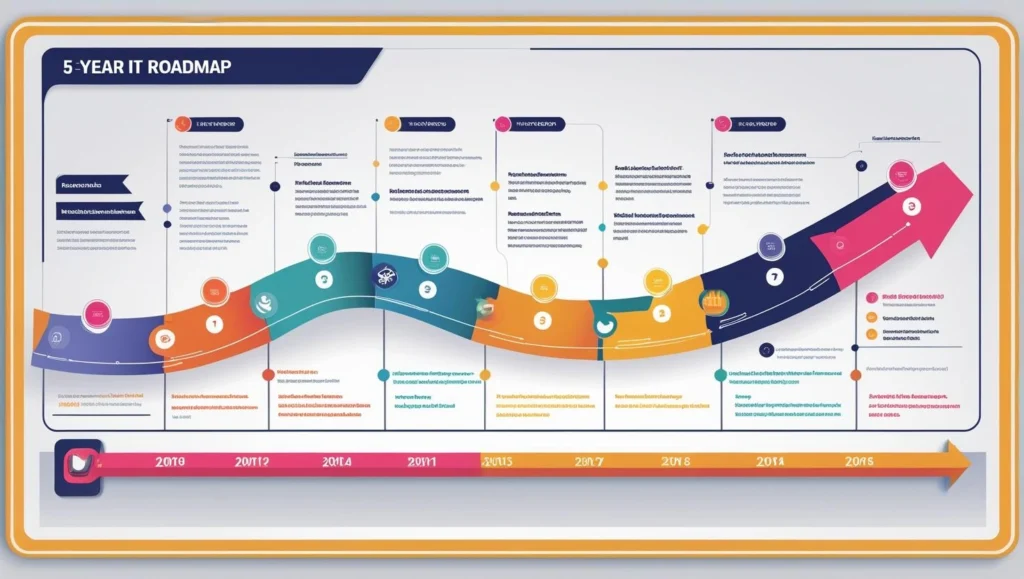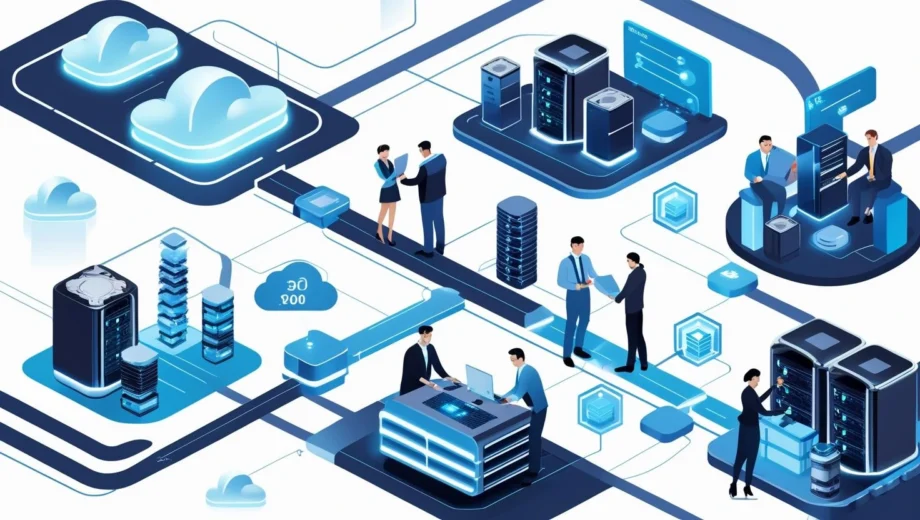🧭 Introduction: Why Long-Term IT Roadmaps Are Critical
In today’s rapidly digitizing world, the need for a structured IT roadmap has become non-negotiable for organizations aiming for long-term scalability, agility, and security. Whether you're a startup, a mid-size company, or a global enterprise, aligning your IT investments with business objectives ensures sustainability and resilience in an unpredictable tech environment.
A well-planned 5-year IT infrastructure roadmap acts as a strategic blueprint, defining how technologies like servers, storage, networking, and cloud computing evolve over time to support growth and innovation. By planning ahead, companies can reduce downtime, lower costs, enhance productivity, and remain competitive.
This article provides a step-by-step guide to building a long-term IT roadmap for organizations. You'll learn about critical infrastructure components, best practices, global trends, and resources like Cisco and CIO Magazine that help you stay informed and ready for the future.”Creating a forward-looking IT infrastructure roadmap is no longer optional—it’s a strategic necessity.”
Related Reading: Nvidia’s Roadmap for AI & GPUs: Powering the Future of Intelligence

Understanding the IT Infrastructure Roadmap
An IT infrastructure roadmap is a long-term strategic plan that outlines the technological framework required to support business operations over several years—typically three to five.
It encompasses hardware (like servers and storage), software, network architecture, cloud integration, and cybersecurity measures. The goal is to align technology capabilities with organizational goals, budgetary forecasts, and evolving industry standards.
For example, a bank planning to implement AI-driven fraud detection in the next 3 years will need to upgrade its data processing infrastructure and cloud security layers as part of its IT roadmap.
Key Components of a 5-Year IT Infrastructure Roadmap
To create a robust roadmap, you must consider both current needs and future goals. Here are the foundational components:
1. Servers and Compute Power
Modern organizations rely on scalable server environments—either on-premise, hybrid, or cloud-based. Key considerations include:
- Server capacity planning (CPU, RAM, storage)
- Virtualization (VMware, Hyper-V)
- Energy efficiency and cooling systems
- Integration with AI/ML workloads
🛠 Emerging Trend: Edge computing is becoming crucial as businesses need localized processing power for faster decision-making.
2. Storage Infrastructure
Data is growing exponentially. Reliable storage is vital for everything from daily operations to compliance and disaster recovery.
- On-premise NAS/SAN systems
- Cloud storage options (AWS S3, Azure Blob, Google Cloud Storage)
- Tiered storage models
- Backup and recovery strategies
Security Tip: Encrypt data at rest and in transit. Integrate identity management tools to control access.
3. Networking and Connectivity
Connectivity forms the backbone of IT operations.
- LAN/WAN architecture planning
- 5G and SD-WAN implementation
- VPN and remote work enablement
- Network segmentation for better security
Scalability Strategy: Use Cisco’s enterprise-grade routers and switches for high-performance networking with centralized management.
4. Cloud Strategy
Most IT roadmaps today are hybrid or cloud-native.
- Evaluate public vs private vs hybrid cloud
- Choose platforms: AWS, Azure, GCP
- Cloud cost optimization
- Disaster Recovery as a Service (DRaaS)
Tip: Ensure workload portability to avoid vendor lock-in.
5. Cybersecurity Framework
Security is foundational, not optional.
- Firewall, antivirus, endpoint detection
- SIEM tools for real-time threat monitoring
- Role-based access control
- Cyber insurance and breach recovery plans
Consult Cisco SecureX for a unified platform offering threat detection, orchestration, and analytics.
6. Scalability and Future-Proofing
Plan for growth:
- Modular infrastructure design
- Cloud elasticity
- Containerization (Docker, Kubernetes)
Prediction: Infrastructure-as-Code (IaC) will become standard by 2027 for automated, reproducible deployments.
📊 How to Plan IT Infrastructure? Best Practices
How to plan IT infrastructure? Follow these best practices:
✔ 1. Align with Business Objectives
Start with your business roadmap. Understand what services, applications, or markets you plan to introduce and what IT capabilities are needed.
✔ 2. Involve Stakeholders
Include department heads, IT leads, finance teams, and even end-users. Each provides unique insights into needs and expectations.
✔ 3. Conduct a Technology Audit
Evaluate your current infrastructure. What’s outdated? What’s underused? Where are the security gaps?
✔ 4. Define KPIs and Milestones
Break down your 5-year roadmap into annual goals. Monitor metrics like uptime, data throughput, and cost per workload.
✔ 5. Choose Scalable Vendors
Select partners with future-forward products—Cisco, Dell, or HP for hardware; Azure or AWS for cloud.

Booking IT Consults: When and Why
Sometimes internal teams lack the bandwidth or expertise for large-scale planning. That’s where professional consultants come in.
🧠 Why Book IT Consults?
- Access to expert infrastructure architects
- Vendor-neutral recommendations
- Proven methodologies
- Compliance and cybersecurity assessments
Actionable Tip: Book IT consult sessions when introducing major changes like cloud migration, ERP deployment, or data center expansion.
Leveraging Resources Like CIO Magazine and Cisco
Stay informed and ahead of the curve by utilizing industry resources.
CIO Magazine
An excellent source for IT strategy, governance, and executive insights. Find articles, case studies, and expert advice for your roadmap.
🔗 Visit: https://www.cio.com (external link)
Cisco
Cisco isn’t just a hardware vendor; it's a full-stack infrastructure solution provider. Explore tools like:
- Cisco DNA Center for automated networking
- Cisco SecureX for integrated cybersecurity
- Cisco Webex for enterprise communication
Global organizations rely on Cisco for scalable, reliable, and secure infrastructure.
Global Considerations and Trends
When building a roadmap for global scalability, factor in the following:
Localization Needs
Data residency laws vary by country (e.g., GDPR in Europe). Use region-specific data centers to stay compliant.
Global IT Challenges
- Diverse compliance regulations
- Varied bandwidth availability
- Cultural considerations in user adoption
Global Innovations
- AI-driven IT ops (AIOps)
- Green IT and sustainability mandates
- Quantum-safe encryption (expected post-2030)
Note: Your roadmap should allow for regional adjustments while maintaining a global IT governance standard.
Conclusion: The Time to Plan Is Now
A 5-year IT infrastructure roadmap is more than a technical document—it’s a strategic asset. It helps you stay ahead of technology trends, ensures business continuity, and supports future growth.With technology evolving rapidly, a well-planned IT infrastructure roadmap helps businesses stay ahead and grow securely.
By focusing on essential elements like servers, storage, cloud, and security—and leveraging resources like Cisco and CIO Magazine—your organization can thrive in an ever-evolving digital world.
Don’t wait for disruption to force change. Start building your IT roadmap today to stay competitive tomorrow








